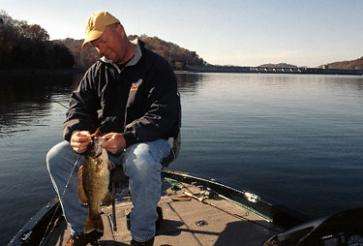
When I’m smallmouth fishing in cold weather, you’ll almost always see me using a shad imitation rather than a crawfish imitation. The reason is simple. Bass feed a lot more on shad when the water’s cold than they do on crawfish.
In the winter, crawfish may not hibernate like bears or some other animals, but they become very lethargic and largely inactive. That means the bass have fewer opportunities to feed on them. At some point, when they stop regularly finding craws, the bass will stop looking for them as much. Once spring rolls around and the craws are more plentiful, you’ll see me tying on more crawfish imitations.
What does this mean on a practical level? Just a couple of things. Instead of using a lot of browns or dark colors with my baits, I’m going to go with lighter colors that look more like baitfish.
And when it comes to manipulating these baits, I’m going to try to make them act more like baitfish (especially shad) than crawfish. That means less crawling and more swimming or gliding along. I’m still going to fish the shad imitations slowly — and often along or near the bottom — but I’m not going to crawl or very slowly hop them like when I’m imitating a crawfish.
It also means that my bait selection may not change very much. I’m still going to have a jig tied on all the time. It’s just that it’ll be a silver or white or light gray jig rather than a darker color.
If I think the fish are active enough to hit a crankbait, I’ll go with a shad pattern. Of course, if they’re that active, the crawfish may be out and vulnerable, too.
One tackle change I sometimes make at this time is to go to lighter lines. In winter, if you’re imitating shad and baitfish rather than craws, you’re generally not fishing in heavy cover, and you can get away with lighter lines. Also, since the bass are lethargic in the cold water, they won’t fight quite as hard. Finally, the water’s usually pretty clear in the winter.
All of that means you need to go to lighter lines.
Of course, the great thing about lighter line is that you’ll usually get more strikes with it. And at this time of the year, when the bass aren’t feeding as much as they do at other times, I’ll take all of the strikes I can get.
It’ll make you a better smallmouth angler.
Until next time, if you have any questions or comments, I’d love to hear from you. Please e-mail me at Stephen@thesmallmouthguru.com.





